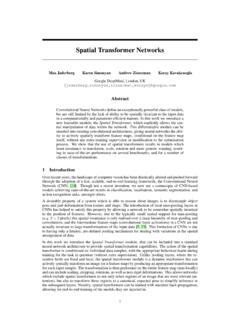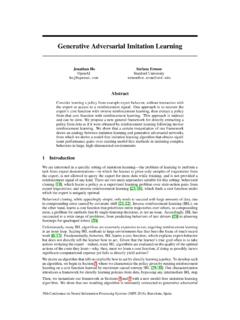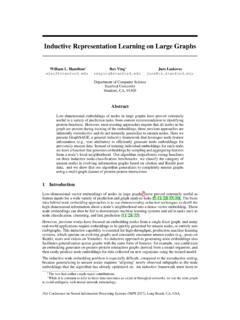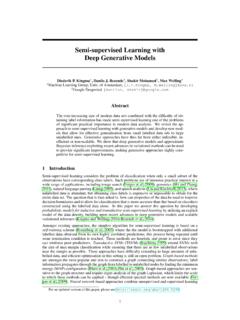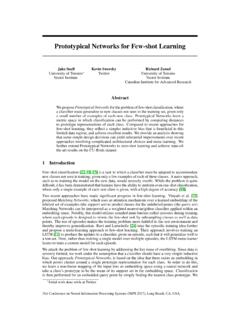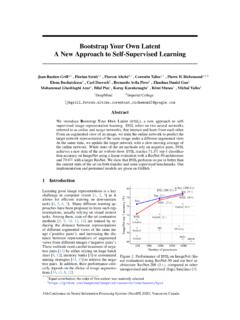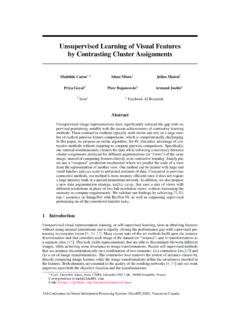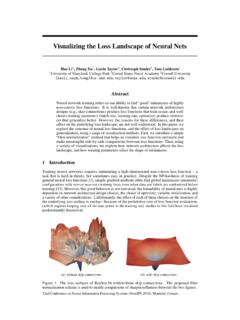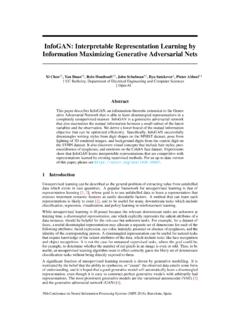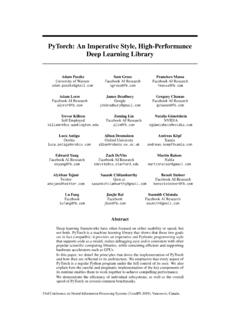Transcription of Algorithms for Hyper-Parameter Optimization - NeurIPS
1 Algorithms for Hyper-Parameter Optimization James Bergstra Re mi Bardenet The Rowland Institute Laboratoire de Recherche en Informatique Harvard University Universite Paris-Sud Yoshua Bengio Bala zs Ke gl De pt. d'Informatique et Recherche Ope rationelle Linear Accelerator Laboratory Universite de Montre al Universite Paris-Sud, CNRS. Abstract Several recent advances to the state of the art in image classification benchmarks have come from better configurations of existing techniques rather than novel ap- proaches to feature learning. Traditionally, Hyper-Parameter Optimization has been the job of humans because they can be very efficient in regimes where only a few trials are possible.
2 Presently, computer clusters and GPU processors make it pos- sible to run more trials and we show that algorithmic approaches can find better results. We present Hyper-Parameter Optimization results on tasks of training neu- ral networks and deep belief networks (DBNs). We optimize hyper - parameters using random search and two new greedy sequential methods based on the ex- pected improvement criterion. Random search has been shown to be sufficiently efficient for learning neural networks for several datasets, but we show it is unreli- able for training DBNs. The sequential Algorithms are applied to the most difficult DBN learning problems from [1] and find significantly better results than the best previously reported.
3 This work contributes novel techniques for making response surface models P (y|x) in which many elements of Hyper-Parameter assignment (x) are known to be irrelevant given particular values of other elements. 1 Introduction Models such as Deep Belief Networks (DBNs) [2], stacked denoising autoencoders [3], convo- lutional networks [4], as well as classifiers based on sophisticated feature extraction techniques have from ten to perhaps fifty hyper - parameters , depending on how the experimenter chooses to parametrize the model, and how many hyper - parameters the experimenter chooses to fix at a rea- sonable default.
4 The difficulty of tuning these models makes published results difficult to reproduce and extend, and makes even the original investigation of such methods more of an art than a science. Recent results such as [5], [6], and [7] demonstrate that the challenge of Hyper-Parameter opti- mization in large and multilayer models is a direct impediment to scientific progress. These works have advanced state of the art performance on image classification problems by more concerted Hyper-Parameter Optimization in simple Algorithms , rather than by innovative modeling or machine learning strategies.
5 It would be wrong to conclude from a result such as [5] that feature learning is useless. Instead, Hyper-Parameter Optimization should be regarded as a formal outer loop in the learning process. A learning algorithm , as a functional from data to classifier (taking classification problems as an example), includes a budgeting choice of how many CPU cycles are to be spent on Hyper-Parameter exploration, and how many CPU cycles are to be spent evaluating each hyper - parameter choice ( by tuning the regular parameters ). The results of [5] and [7] suggest that with current generation hardware such as large computer clusters and GPUs, the optimal alloca- 1.
6 Tion of CPU cycles includes more Hyper-Parameter exploration than has been typical in the machine learning literature. Hyper-Parameter Optimization is the problem of optimizing a loss function over a graph-structured configuration space. In this work we restrict ourselves to tree-structured configuration spaces. Con- figuration spaces are tree-structured in the sense that some leaf variables ( the number of hidden units in the 2nd layer of a DBN) are only well-defined when node variables ( a discrete choice of how many layers to use) take particular values. Not only must a Hyper-Parameter Optimization algo- rithm optimize over variables which are discrete, ordinal, and continuous, but it must simultaneously choose which variables to optimize.
7 In this work we define a configuration space by a generative process for drawing valid samples. Random search is the algorithm of drawing Hyper-Parameter assignments from that process and evaluating them. Optimization Algorithms work by identifying Hyper-Parameter assignments that could have been drawn, and that appear promising on the basis of the loss function's value at other points. This paper makes two contributions: 1) Random search is competitive with the manual Optimization of DBNs in [1], and 2) Automatic sequential Optimization outperforms both manual and random search.
8 Section 2 covers sequential model-based Optimization , and the expected improvement criterion. Sec- tion 3 introduces a Gaussian Process based Hyper-Parameter Optimization algorithm . Section 4 in- troduces a second approach based on adaptive Parzen windows. Section 5 describes the problem of DBN Hyper-Parameter Optimization , and shows the efficiency of random search. Section 6 shows the efficiency of sequential Optimization on the two hardest datasets according to random search. The paper concludes with discussion of results and concluding remarks in Section 7 and Section 8.
9 2 Sequential Model-based Global Optimization Sequential Model-Based Global Optimization (SMBO) Algorithms have been used in many applica- tions where evaluation of the fitness function is expensive [8, 9]. In an application where the true fitness function f : X R is costly to evaluate, model-based Algorithms approximate f with a sur- rogate that is cheaper to evaluate. Typically the inner loop in an SMBO algorithm is the numerical Optimization of this surrogate, or some transformation of the surrogate. The point x that maximizes the surrogate (or its transformation) becomes the proposal for where the true function f should be evaluated.
10 This active-learning-like algorithm template is summarized in Figure 1. SMBO algo- rithms differ in what criterion they optimize to obtain x given a model (or surrogate) of f , and in they model f via observation history H.. SMBO f, M0 , T, S. 1 H , 2 For t 1 to T , 3 x argminx S(x, Mt 1 ), 4 Evaluate f (x ), . Expensive step 5 H H (x , f (x )), 6 Fit a new model Mt to H. 7 return H. Figure 1: The pseudo-code of generic Sequential Model-Based Optimization . The Algorithms in this work optimize the criterion of Expected Improvement (EI) [10]. Other cri- teria have been suggested, such as Probability of Improvement and Expected Improvement [10], minimizing the Conditional Entropy of the Minimizer [11], and the bandit-based criterion described in [12].
